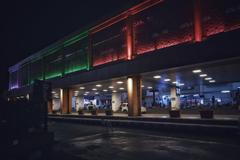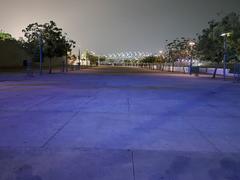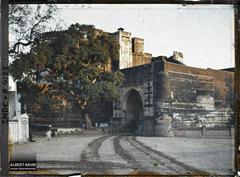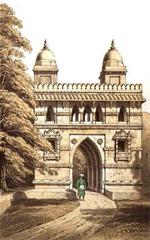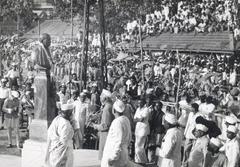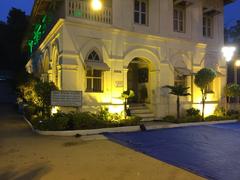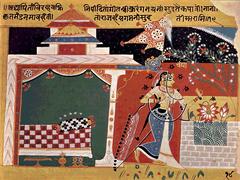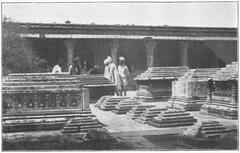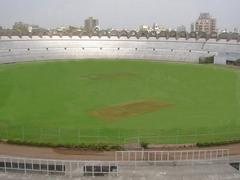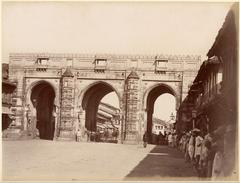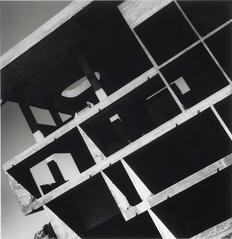
Atma House Visiting Hours, Tickets, and Historical Significance in Ahmedabad
Date: 04/07/2025
Introduction: Atma House and Its Cultural Importance
Atma House, officially known as the Mill Owners’ Association Building, is one of Ahmedabad’s most celebrated examples of modernist architecture and industrial heritage. Designed by the renowned Swiss-French architect Le Corbusier in the mid-1950s, Atma House was commissioned as the administrative headquarters for Ahmedabad’s influential textile magnates, symbolizing the city’s transformation into the “Manchester of India.” The building’s strategic location between Ashram Road and the Sabarmati River, along with its synthesis of modernist design and local climatic considerations, marks it as a pivotal site in India’s architectural evolution (ArchDaily).
Le Corbusier’s design for Atma House features pioneering elements such as brise-soleil (sun-breakers), a ceremonial ramp, and exposed béton brut (raw concrete), addressing the region’s climate while creating a sophisticated interplay of light, shadow, and air. Today, Atma House is not just an architectural landmark; it is a dynamic cultural venue that hosts conferences, design festivals like ELEV8, and exhibitions, continuing Ahmedabad’s legacy as a center of innovation and architectural excellence.
This guide draws upon authoritative sources to offer a comprehensive exploration of Atma House’s history, architectural features, cultural significance, and essential visitor information (The Architect’s Diary; Abirpothi; Knocksense).
Contents
- Origins: Ahmedabad’s Textile Legacy
- Commissioning Le Corbusier
- Design and Construction
- Architectural Innovations
- Symbolism and Cultural Relevance
- Legacy and Influence
- Visiting Information: Hours, Tickets, Tours, Accessibility
- Nearby Attractions
- FAQs
- Visual and Multimedia Experience
- Summary & Recommendations
- Sources
Origins: Ahmedabad’s Textile Legacy
Ahmedabad earned its reputation as the “Manchester of India” through its thriving textile industry in the early to mid-20th century. The Mill Owners’ Association represented the city’s textile magnates and sought a headquarters that would reflect both their industrial power and progressive vision. By commissioning Le Corbusier, they aimed to create a landmark that merged international modernism with local aspirations (ArchDaily).
Commissioning Le Corbusier: Vision Meets Modernism
Le Corbusier’s engagement with Ahmedabad began after his invitation to design Chandigarh. Surottam Hutheesing, then president of the Mill Owners’ Association, played a crucial role in bringing Le Corbusier to the city. Atma House was the first of several major projects the architect undertook in Ahmedabad, setting the stage for the city’s transformation into a showcase of modern Indian architecture (ArchDaily; Faculty of Architecture, Texas A&M).
Design and Construction
Constructed between 1954 and 1956, Atma House stands about 58 feet tall and includes three primary floors. Le Corbusier’s design balances functionality with climatic responsiveness, featuring deep overhangs, brise-soleil, and open terraces that provide shade and ventilation—vital for Ahmedabad’s intense heat (ArchDaily).
Architectural Innovations
Brise-Soleil and Environmental Response
The most distinctive feature is the brise-soleil system: diagonally placed sun-breakers on the west façade shield the interiors from direct sunlight while encouraging cross-ventilation. The rear façade, facing the Sabarmati River, uses perpendicular brise-soleil to channel river breezes and frame scenic views, referencing the city’s textile heritage (ArchDaily).
Spatial Organization
A ceremonial ramp leads visitors through a triple-height atrium, creating a dramatic spatial experience. The building’s plan zones clerks and canteen on the ground floor, executive offices and boardroom on the first floor, and a top-lit auditorium on the uppermost level (The Architect’s Diary; Wikipedia).
Materiality and Structure
The building’s exposed concrete, brickwork, and open plans exemplify Le Corbusier’s modernist vocabulary and adaptation to Indian conditions (aha.nascentinfo.com).
Symbolism and Cultural Relevance
Atma House is a physical manifesto of post-independence India’s aspirations, merging Western modernism with Indian traditions. The interplay of robust forms, deep-set windows, and shaded terraces speaks to both functional needs and the culture of communal gathering. The building became a symbol of the city’s industrial power and cosmopolitan spirit (ArchDaily).
Legacy and Influence
Atma House profoundly influenced Indian architecture, inspiring generations of architects and serving as a model for climate-responsive, contextual design. Its legacy is seen in later works both in India and abroad and is recognized as part of the UNESCO World Heritage site “The Architectural Work of Le Corbusier” (The Architect’s Diary).
Visiting Information
Visiting Hours
- Regular Hours: 10:00 AM – 5:00 PM, Tuesday to Sunday
- Closed: Mondays and public holidays
- Special Events: Hours may extend during festivals like ELEV8; check event listings for updates
Tickets & Entry
- General Entry: Free
- Events/Tours: Some special events may require prior registration or a nominal fee (typically INR 50 for general admission; students and professionals with valid ID often enter free during events)
- Guided Tours: Available by prior arrangement, especially during weekends or special events
Accessibility
- Wheelchair Access: Ramps and elevators are available for main areas
- Note: Some upper floors and terraces may have limited accessibility due to original design constraints
Travel Tips
- Location: Ashram Road, near the Sabarmati River
- Public Transport: Well-connected by Ahmedabad’s BRTS, auto-rickshaw, and taxi
- Parking: Available onsite and nearby
- Best Time to Visit: November–February for pleasant weather
Nearby Attractions
When visiting Atma House, consider exploring:
- Sabarmati Ashram: Mahatma Gandhi’s historic home
- Sanskar Kendra: Another Le Corbusier design, now a city museum
- Calico Museum of Textiles: Renowned textile collection
- Sidi Saiyyed Mosque: Famous for its intricate latticework
FAQs
Q: Is Atma House open every day?
A: No. It is closed on Mondays and public holidays.
Q: What is the entry fee?
A: Entry is usually free; special events may carry a nominal fee.
Q: Are guided tours available?
A: Yes, by advance booking or during scheduled events.
Q: Is the building accessible for people with disabilities?
A: Main areas are accessible; some upper levels may have limitations.
Q: Can I take photographs?
A: Yes, in public areas. For interior or event photography, seek permission.
Visual and Multimedia Experience
Enhance your visit with high-quality images and interactive maps available on architecture and tourism platforms. Look for visuals highlighting Atma House’s brise-soleil, ceremonial ramp, and river views.
Summary and Visitor Recommendations
Atma House exemplifies Ahmedabad’s leadership in industrial and architectural innovation, standing as a testament to the city’s partnership with Le Corbusier. Its climate-adaptive design, cultural symbolism, and role as a living venue for events and education continue to inspire. Plan your visit around guided tours or special events for the richest experience, and explore nearby historical sites to fully immerse in Ahmedabad’s heritage. Stay updated with official resources, and use the Audiala app for audio-guided experiences and event notifications.
Sources and Further Reading
- ArchDaily: Atma House Ahmedabad – Visiting Hours, Tickets, and Architectural History
- The Architect’s Diary: Visiting Atma House (Mill Owners’ Association Building)
- Abirpothi: ATMA House Ahmedabad – Visiting Hours, Tickets, and Architectural Legacy
- Knocksense: Visiting ATMA House – Ahmedabad’s Modernist Architectural Gem
- Parametric Architecture: Ahmedabad City Guide
- aha.nascentinfo.com: Heritage Site Details
- India Art Fair: A Culture Lover’s Guide to Ahmedabad
- Wikipedia: Mill Owners’ Association Building
For further inspiration and up-to-date event listings, download the Audiala app and follow our dedicated platforms celebrating Ahmedabad’s architectural treasures.

